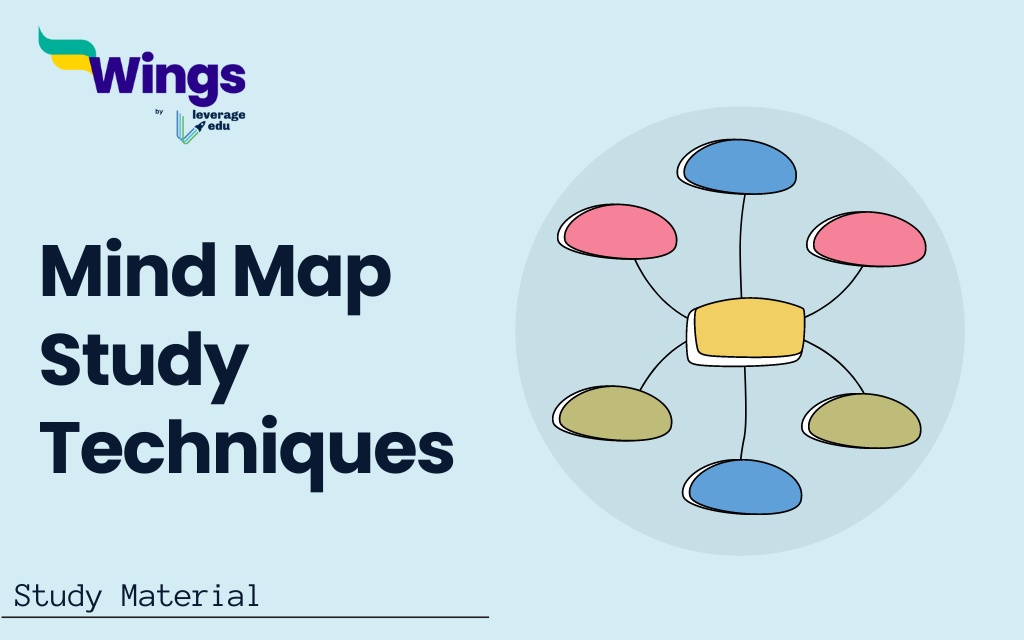Feeling overwhelmed by the volume of material you need to learn for your upcoming competitive exam? Don’t spend more time making linear notes but rather learn mind mapping, a powerful visual study technique that can transform your exam prep strategy. Mind maps are tools of creativity, helping in memory retention and comprehension. By linking important concepts visually, you’ll understand complex topics faster and recall them with ease during exams. Use colours, images, and connections to create comprehensive mind maps tailored to your learning style. Read this article to learn how you can use mind map study techniques for upcoming government exams
| Purpose of mind map study techniques | Mind mapping is an effective method for generating ideas by association, helping in brainstorming, note-taking, problem-solving, decision-making, and organising information. |
| Structure of mind map study techniques | –The central theme/main idea is placed in the centre of the page, with keywords, phrases, concepts, facts, and figures radiating outward in all directions. –Lines, arrows, speech bubbles, branches, and colors are used to show connections and relationships between ideas. |
| Applications of mind map study techniques | –Taking notes in lectures –Showing links and relationships between main ideas – Brainstorming more ideas — Organizing ideas and information – Reviewing learning for tests or exams |
| Implementation Tips | — Place the central theme/main idea in the center of the page. — Use various visual elements to connect ideas. — Draw quickly without major editing. — Use different colors to symbolize different aspects — Leave space on the page for additional ideas. — Consider using A3 paper for more space if needed. |
| Benefits of mind map study techniques | – Provides an overview of broad topics – Encourages seeing the bigger picture – Offers an attractive and enjoyable format for organizing information |
Must Read: Richard Feynman Learning Method
Why Mind Map Study Techniques are Perfect for Exam Prep?
Imagine a mindmap_- a central topic with connected branches holding important ideas, sub-topics, and supporting details. That’s the importance of mind mapping! It mimics the natural way our brains process information, making connections leading to better understanding. Here we have mentioned why you must use mind map study techniques for competitive exam preparation:
- Visually appealing colours, images, and keywords trigger a memory, making information more memorable than endless paragraphs.
- The hierarchical structure of mind maps helps you categorize information, identify connections between topics, and pinpoint knowledge gaps.
- Creating a mind map forces you to actively engage with the material, analyze relationships between concepts, and synthesize information.
- A single look at your mind map can refresh your memory and maximize your study time.
Must Read: Academic Burnout: Symptoms and Tips to Avoid
How to Use Mind Map Study Techniques for Competitive Exams
Use mind map study techniques for competitive exams by centralizing main topics, branching out with subtopics, and connecting related ideas visually. Here we have listed how one should use mind map study techniques for exam prep:
- Paper, pens, highlighters, and your textbook or study materials are all you need.
- Write the main subject of your exam or a specific chapter in the center of the page.
- Draw main branches radiating outwards, representing important themes or sub-topics.
- On each branch, add keywords, short phrases, or visuals that represent important details within each sub-topic.
- Use arrows, lines, or colors to highlight relationships and connections between different branches and sub-topics.
- Don’t be afraid to use colors, icons, and even doodles to increase visual memory and make your mind map engaging.
Must Read: Pomodoro Technique for Studying
Tips for Using Mind Map Study Techniques
Mind mapping is a very important tool that can be adapted to different learning styles and exam formats. So, use your creativity, draw your mind maps, and perform well in those competitive exams! Follow the below-mentioned tips to effectively use mind map study techniques:
- Use concise and impactful keywords to represent important concepts.
- Incorporate useful tricks like acronyms or rhymes to increase recall.
- As you progress through your studies, keep adding details and connections to your existing mind map.
- Once your mind map is complete, test yourself by covering up sections and trying to recall the missing information.
FAQs
Mind mapping use techniques such as association, visualization, summarization, and hierarchical organization of information for effective learning.
Mind map analysis involves examining connections, patterns, and relationships depicted in a mind map to extract insights or identify key concepts.
The best technique for an effective mind map includes starting with a central idea, using keywords, colors, and images, and creating interconnected branches.
To draw a mind map for studying, begin with a central topic, branch out to subtopics, use keywords, and images, and organize information hierarchically.
This was all about the “Mind Map Study Techniques”. For more such informative blogs, check out our Study Material Section, or you can learn more about us by visiting our Indian exams page.
 One app for all your study abroad needs
One app for all your study abroad needs














